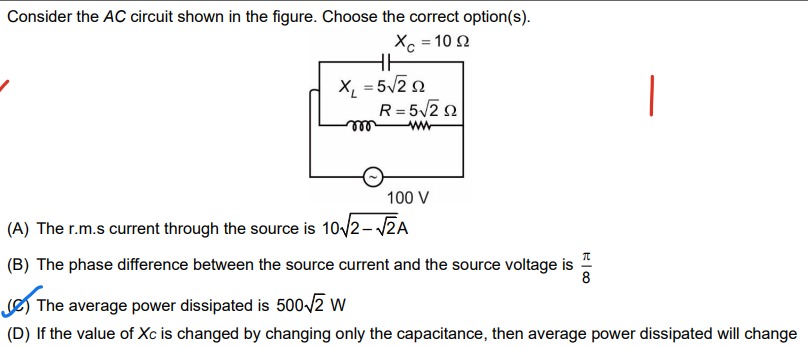Question
Question: Consider the AC circuit shown in the figure. Choose the correct option(s)....
Consider the AC circuit shown in the figure. Choose the correct option(s).

The r.m.s current through the source is 102−2A
The phase difference between the source current and the source voltage is 8π
The average power dissipated is 5002 W
If the value of Xc is changed by changing only the capacitance, then average power dissipated will change
B, C
Solution
The given AC circuit consists of a voltage source in parallel with a capacitor and a series combination of an inductor and a resistor. The rms voltage of the source is Vrms=100 V. The capacitive reactance is XC=10Ω, the inductive reactance is XL=52Ω, and the resistance is R=52Ω.
The voltage across each parallel branch is equal to the source voltage. The rms current through the capacitor is IC,rms=XCVrms=10100=10 A. This current leads the voltage by 90∘. The impedance of the series RL branch is ZRL=R+jXL=52+j52Ω. The magnitude of the impedance is ∣ZRL∣=R2+XL2=(52)2+(52)2=50+50=100=10Ω. The rms current through the RL branch is IRL,rms=∣ZRL∣Vrms=10100=10 A. The phase angle of the RL branch impedance is ϕRL=arctan(RXL)=arctan(5252)=arctan(1)=45∘=4π radians. The current through the RL branch lags the voltage by 4π.
To find the total rms current through the source, we need to add the currents from the two branches as phasors. Let the voltage be represented by a phasor V=100∠0∘. The current through the capacitor is IC=10∠90∘=10j. The current through the RL branch is IRL=10∠−45∘=10(cos(−45∘)+jsin(−45∘))=10(21−j21)=52−j52. The total source current is Isource=IC+IRL=10j+(52−j52)=52+j(10−52). The rms value of the source current is ∣Isource,rms∣=(52)2+(10−52)2=50+100−1002+50=200−1002=102−2. Option (A) states the rms current is 102−2=92. Since 102−2=92, option (A) is incorrect.
The phase angle of the source current relative to the voltage is ϕsource=arctan(5210−52)=arctan(5210−5252)=arctan(22−1)=arctan(2−1). We know that tan(8π)=2−1. Since the real and imaginary parts of Isource are positive, the phase angle is 8π. The phase difference between the source current and the source voltage is ∣ϕsource∣=8π. Option (B) states that the phase difference is 8π. This is correct.
The average power dissipated in the circuit is dissipated only in the resistor. The capacitor and inductor do not dissipate average power. The average power dissipated in the resistor is Pavg=IRL,rms2R. We found IRL,rms=10 A and R=52Ω. Pavg=(10)2×52=100×52=5002 W. Option (C) states that the average power dissipated is 5002 W. This is correct.
If the value of XC is changed by changing only the capacitance, the impedance of the capacitor branch changes. However, the voltage across the RL branch remains the source voltage, and the impedance of the RL branch (ZRL=R+jXL) remains unchanged since R and XL are not changed. The rms current through the RL branch is IRL,rms=∣ZRL∣Vrms. Since Vrms and ∣ZRL∣ are unchanged, IRL,rms remains unchanged. The average power dissipated is Pavg=IRL,rms2R. Since IRL,rms and R are unchanged, the average power dissipated remains unchanged. Option (D) states that if the value of XC is changed by changing only the capacitance, then average power dissipated will change. This is incorrect.
The correct options are (B) and (C).
